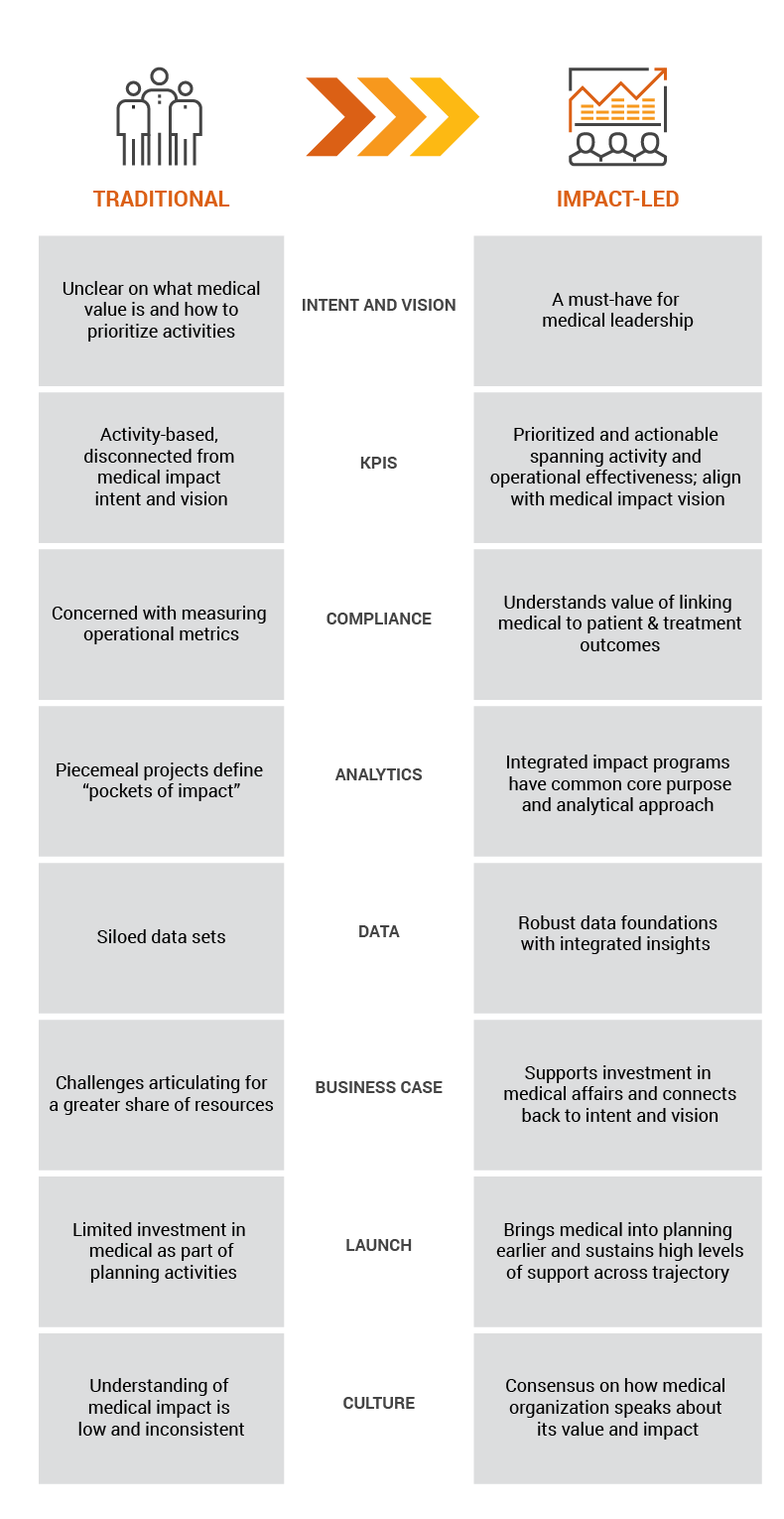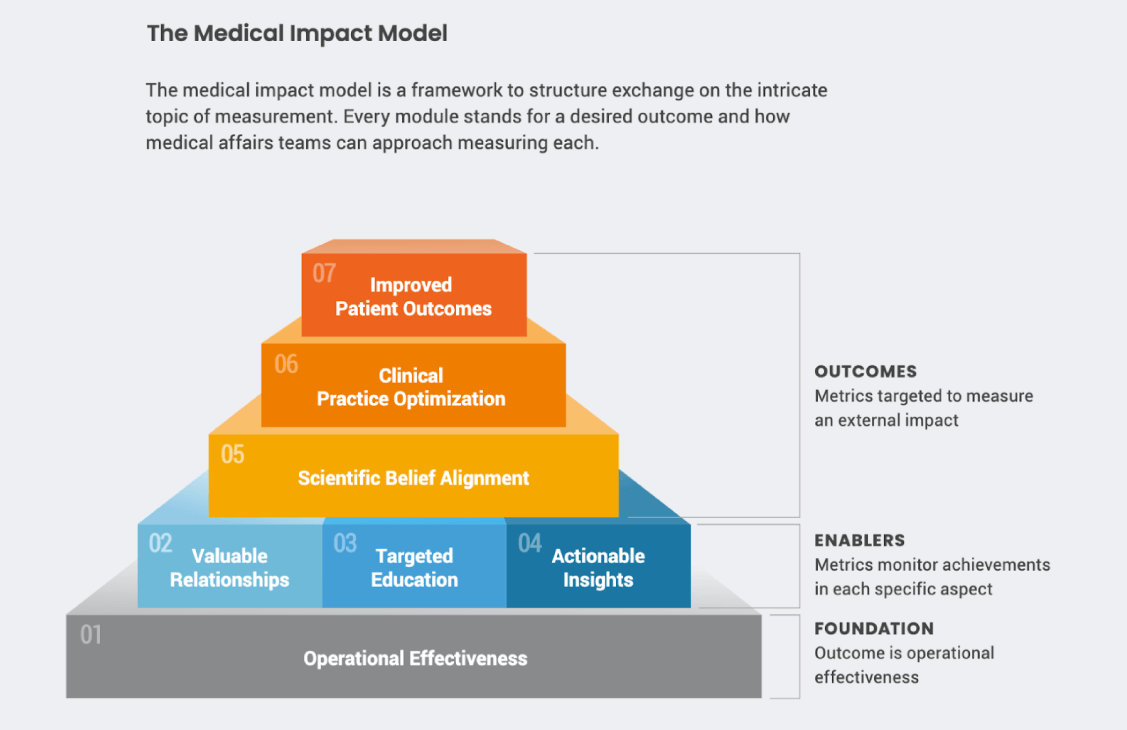Leading with Impact: How Medical Affairs Teams Can Get Started
In a recent survey, 64% of medical leaders expressed that advanced, patient-centric metrics — indicators of change in clinical practice (44%) and scientific beliefs (20%) — should be the key outcome metrics for their teams.1 But while many medical affairs organizations want to be more patient-focused, only a small percentage – less than 15% – are actually implementing these advanced metrics.2
Most medical affairs teams currently focus on general activity measurements, including the number of interactions by field medical, the frequency of interactions with customers, and the amount of insights captured. To truly translate its value across the organization, medical affairs must also incorporate metrics that better reflect its overarching goal – ensuring that science and technologies benefit patients. The ability to show the impact of activities is necessary to further its role and influence especially when it comes to decision power, budget, and strategic leadership. A strong operational foundation is essential to making this shift and for continued success.
What does an impact-led organization look like?
Many medical affairs organizations want to become impact-led, but may not know how to get there. Shifting from a traditional model to becoming more outcome-led requires making changes across many areas including:

The medical impact model: A new framework for measuring impact
Medical affairs organizations have struggled to measure impact due to a lack of a standard industry approach. The medical impact model is a holistic approach to measuring impact, starting with simple measurement and increasing in complexity as the focus areas become more intricate and require more complex analytics. It goes beyond operational activity metrics and emphasizes new areas of impact – those closer to the patient – including changing medical practice and improving patient outcomes.

Because it takes a modular approach, the model offers organizations the flexibility to prioritize the modules that make the most sense for their therapeutic area type, product lifecycle stage, and the maturity and quality of the data used. For example, an organization in pre-launch with a specialty drug will focus on different modules than organizations working on more mature products.

How to move toward an impact-led medical affairs organization
No matter where you are in the product lifecycle, building a strong foundation of operational effectiveness is the first step every organization must take. This means having the right data, metrics, and integrated technology that is fit-for-purpose for medical, as well as the who and what – people, process, and culture – to make this shift. Laying this strong groundwork is also necessary to move into more complex areas of impact, like improved patient outcomes. Concentrating on the following four areas will help shift mindset and move toward being impact-led.
- Track customer and medical activity data: It’s important to get a complete view of how the entire organization engages with the customer – across medical, clinical, and commercial. This requires everyone to document customer insights, activities, and interactions. A CRM system can help teams organize and make this data accessible to everyone. Without it, you cannot analyze the data and substantiate impact.
- Validate your data: Once you have data, determine what you can do with it. Test your hypotheses using different datasets with proofs of concept to determine what is possible, valuable, and compliant in your current ecosystem.
- Get leadership buy-in: Becoming more impact-led is a strategic pivot that affects every part of the organization. Medical leadership needs to own and be involved from the start to move impact initiatives forward. Their involvement should go beyond just giving MSLs new KPIs. They should provide clear direction, and a definition of what measuring medical impact means for the organization.
- Outline a capability blueprint: Once you have leadership buy-in, you need a plan for how you will move through your journey. Outline a change management document with clear priorities for building or rebuilding capabilities to sustain and elevate your impact-led organization. This plan should go beyond metrics and include new processes, culture, additional headcount, and ways of working to shift from a traditionally siloed to a more unified organization. This will also help your team determine where to start and how to move from one module to another in the medical impact model.
Assessing where your organization is and what you’re working toward can help you clearly define a plan of action. For example, you may be at a greater level of maturity in one area than another and, therefore, might prioritize those less mature areas.
Getting to a more patient-centric way of measuring impact takes time and planning, but many medical organizations are already testing the waters and trying new ways to measure impact. Start by identifying where you are in your journey and where you want to go. Then begin building a strong foundation of operational effectiveness to support that journey. This includes ensuring you have the right tools to track and share data and insights, and the right people to make and support this change.
Learn how Veeva Medical Business Consulting can help you move toward a more impact-led organization.
1 Based on Veeva survey of medical affairs leaders, November, 2023.
2 Veeva internal, non-published data, November, 2023.